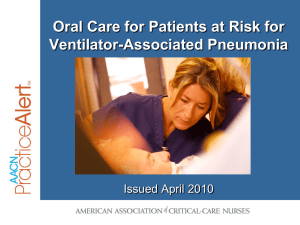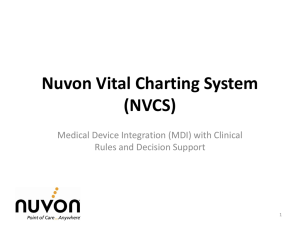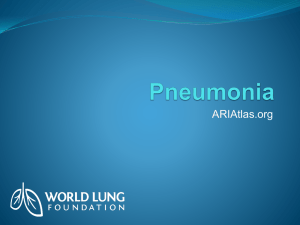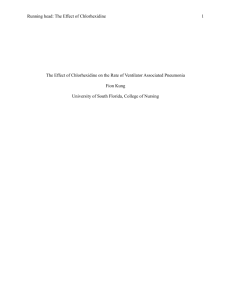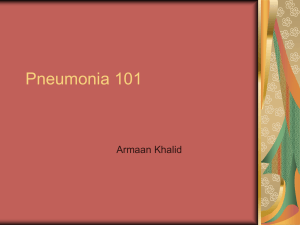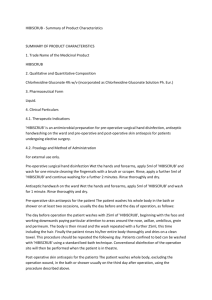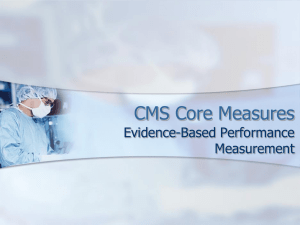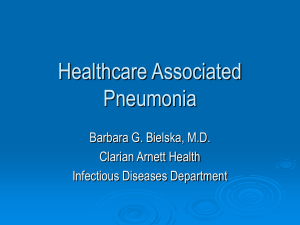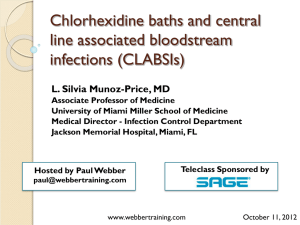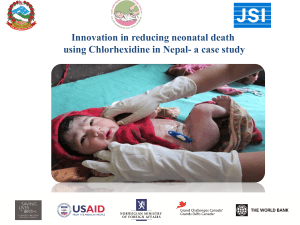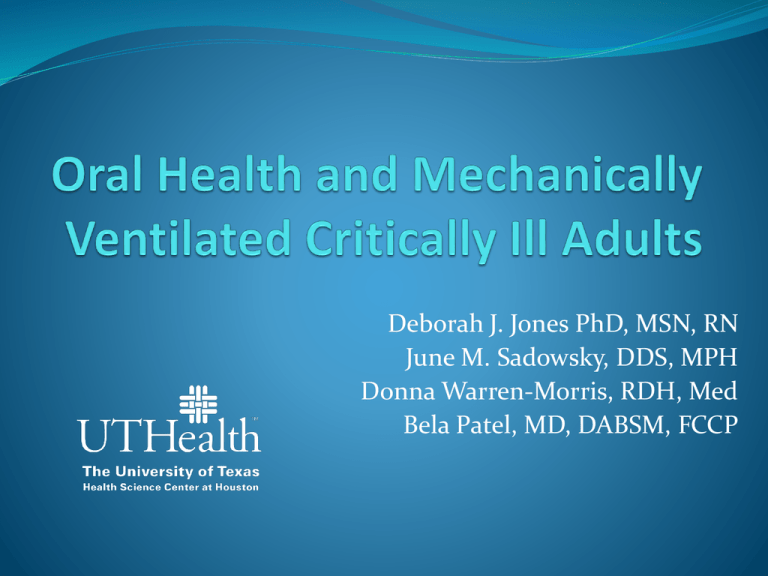
Deborah J. Jones PhD, MSN, RN
June M. Sadowsky, DDS, MPH
Donna Warren-Morris, RDH, Med
Bela Patel, MD, DABSM, FCCP
Outcomes
Define components of oral health in mechanically
ventilated adults
Recognize complications from poor oral health
Promote good oral health through the delivery of
appropriate oral hygiene
Describe the state of the science regarding oral care
practices in mechanically ventilated adults
Assess and deliver evidence-based oral care
Recognize triggers to consult other healthcare
providers
Oral and Systemic Health Link
Diabetes
Cardiovascular disease
Respiratory disease
Stroke
Premature birth
Mechanically Ventilated Patients
Characteristics:
Vulnerable to systemic infections due to disruption in
host defenses like mucociliary clearance, cytokine
production and salivary volume
Dependent on healthcare providers to provide oral care
Have the potential for bacterial load to be increased due
to lack of consistent oral care regimen
Develop oropharyngeal colonization with pathogenic
organisms within the first 24 hours of intubation
Reasons for Lack of Oral Care Regimen
Nurses receive little to no formal training
Lack of priority, perceived need or time
Patient’s inability to participate or request
Medical conditions and equipment interfere
Fear of endotracheal tube dislodgement
Lack of published randomized controlled trials
examining the best practices for oral care in critically
ill patients
Complications of Poor Oral Hygiene
Oropharyngeal colonization linked to the
development of ventilator-associated pneumonia
(VAP)
Remains the most deadly hospital acquired infection in
intensive care units (8-15% estimated mortality rate)
Increased dental plaque accumulation and oral
inflammation
Disruption of tissue integrity
Further complication of pre-existing oral conditions
Rationale for Good Oral Hygiene
Oral care protocols (usually included in VAP bundles)
show decrease in incidence of VAP
Oral care reflects preventive measures aimed at
reducing pathogenic organisms, and promoting
holistic patient care
Patient comfort
Prevention of halitosis
Although…to date
No gold standard oral care protocol with optimal
frequency or products have been well established;
several organizations have published
recommendations to guide oral care of the
mechanically ventilated patient
Institute for Healthcare Improvement (IHI)
American Association of Critical-Care Nurses
(AACN)
Centers for Disease Control and Prevention (CDC)
Institute for Healthcare Improvement
(IHI) Recommendation
Daily oral care with 0.12% chlorhexidine
• Develop a comprehensive oral care process that includes
the use of 0.12% chlorhexidine oral rinse
• Schedule chlorhexidine as a medication, which then
provides a reminder for the RN and triggers oral care
process delivery
Educate the RN staff about the rationale supporting
good oral hygiene and its potential benefit in reducing
ventilator-associated pneumonia
American Association of Critical-Care
Nurses (AACN) Recommendation
Develop and implement a comprehensive oral hygiene
program for patients in critical care and acute care settings
who are at high risk for ventilator-associated pneumonia
(VAP)
Brush teeth, gums and tongue at least twice a day using a soft
pediatric or adult toothbrush
Provide oral moisturizing to oral mucosa and lips every 2 to 4
hours
Use an oral chlorhexidine gluconate (0.12%) rinse twice a day
during the perioperative period for adult patients who
undergo cardiac surgery
Routine use of oral chlorhexidine gluconate (0.12%) in other
populations is not recommended at this time
Centers for Disease Control and
Prevention(CDC) Recommendation
Perform regular oral care with an
antiseptic solution
The optimal frequency for oral care is
unresolved
Oral Care Protocol for Intubated
Patients
Follow standard precautions and infection prevention
procedures including asepsis, gloves, a mask, and eye
protection (as needed)
Obtain all necessary equipment prior to beginning
oral care
Explain to the patient what you are planning to do so
they are not startled
Note the position and placement of the endotracheal
tube prior to oral care
Assessment and Oral Cancer
Screening
Assess all areas of the mouth for any signs of trauma,
inflammation, bleeding, ulcerations or suppuration
Redness, swelling, exudate, tenderness and ulcerations
are signs of infections that should be further assessed to
rule out oral cancer.
Assessment
Slight bleeding of the gums is common if
homecare has been deficient. With good
oral hygiene, bleeding will cease in a few
days of adequate care
Xerostomia (dry mouth)
Common in intubated patients
Assessment
Assessment of the oral cavity should include all
surfaces of the mouth, carefully inspecting for
abnormalities.
When inspecting the intubated patient be careful to
observe the position and placement of the
endotracheal tube.
Suctioning
Prior to beginning the oral care protocol and
immediately following oral care it is
important to suction the patients mouth
and the subglottic space in order to prevent
aspiration of pooled secretions
Suctioning should be repeated as needed
during oral care
Tooth Brushing
The teeth and mouth should be cleaned at least twice a
day
Use a soft bristle toothbrush with a small head
(pediatric size) for better access
A smear of a sodium fluoride toothpaste
Do not use a sodium monofluorophosphate fluoride if
chlorhexidine gluconate is to be used since the two are
not compatible
Tooth Brushing Technique
Use a systematic sequence
Angle the bristles toward the gumline and brush with
gentle pressure in small circular strokes on each tooth.
The bristles of the toothbrush will extend underneath
the gumline if adapted correctly
Facial surfaces of all maxillary teeth, then linguals, then
repeat on the mandibular teeth. Brush the occlusal or
biting/chewing surfaces last with a scrub stroke
Brush the tongue with long outward sweeping strokes
Gently move the tube from side to side as necessary for
access
Tooth Brushing
Teeth should be brushed in a circular motion.
Teeth of mechanically ventilated adults should be
brushed using the same technique with the exception
of the following modifications:
observe the placement of the endotracheal tube by the
markings on the tube before and during oral care,
suction the oral cavity frequently and suction the
subglottic space following oral care to prevent
aspiration .
A mouth prop, tongue blade or bite block may be used to
hold the mouth open for unresponsive patients
Antiseptic/microbial application
Antimicrobial
Chlorhexidine gluconate (0.12%)
Recommended with little side effects (tooth staining)
Swab the endotracheal tube as well to prevent bacterial
biofilm formation
Swab twice a day with no rinsing afterward for a
minimum of 30 minutes
Moisturizing the Mouth
Every two hours, moisturize the lips,
mucosa, tongue and corners of the mouth
with a water-based moisturizer
Petroleum based products should be
avoided as they can dry tissues and are
harmful if aspirated
Detrimental Practices.
Foam Swabs do not
remove plaque bacteria
as well as a toothbrush
and should not be
substituted
Hydrogen peroxide is
acidic and can burn
soft tissues if not
diluted enough and
may also cause black
hairy tongue
Lemon glycerin swabs are
very acidic and can cause
soft tissue burns and
decalcify the teeth
Petroleum jelly dries out
oral tissues and can also
degrade latex gloves
Special Considerations
Neuroscience patients
Intracranial pressure
Edentulous patients
Brush the gums gently
Facial trauma patients
Modify tooth brushing
Role of Healthcare Providers
Nurses
Patient and other healthcare provider education
Daily assessment of oral cavity
Delivery and documentation of oral care
Consultation as needed
Respiratory Therapists
Further assessment around endotracheal tube holders
Maintenance of closed ventilation circuit
Role of Healthcare Providers
Physicians/Nurse Practitioners/Physician Assistants
Oral assessments
Routine/standard order of antimicrobial rinse
Collaboration with dental professionals
Patient education
Dental Hygienists/Dentists
Referral follow-up
Collaboration with critical care clinicians
References
Berra L, Sampson J, Wiener-Kronish J. Pseudomonas aeruginosa: Acute lung
injury or ventilator-associated pneumonia? Minerva Anestesiol.
2010;76(10):824-832.
Nseir S, Di Pompeo C, Pronnier P, et al. Nosocomial tracheobronchitis in
mechanically ventilated patients: Incidence, aetiology and outcome. Eur Respir
J. 2002;20(6):1483-1489.
Craven DE, Driks MR. Nosocomial pneumonia in the intubated patient. Semin
Respir Infect. 1987;2(1):20-33.
Torres A, El-Ebiary M, Gonzalez J, et al. Gastric and pharyngeal flora in
nosocomial pneumonia acquired during mechanical ventilation. Am Rev Respir
Dis. 1993;148(2):352-357.
Greene R, Thompson S, Jantsch HS, et al. Detection of pooled secretions above
endotracheal-tube cuffs: Value of plain radiographs in sheep cadavers and
patients. Am J Roentgenol. 1994;163(6):1333-1337.
References
Jones DJ, Munro CL, Grap MJ. Natural history of dental plaque accumulation in
mechanically ventilated adults: A descriptive correlational study. Intensive Crit
Care Nurs. 2011;27(6):299-304. doi: 10.1016/j.iccn.2011.08.005.
Munro CL, Grap MJ, Jones DJ, McClish DK, Sessler CN. Chlorhexidine,
toothbrushing, and preventing ventilator-associated pneumonia in critically ill
adults. American Journal of Critical Care. 2009;18(5):428-437. Accessed 25
February 2011.
Fourrier F, Duvivier B, Boutigny H, Roussel-Delvallez M, Chopin C.
Colonization of dental plaque: A source of nosocomial infections in intensive
care unit patients. Crit Care Med. 1998;26(2):301-308.
Barkvoll P, Rölla G, Bellagamba S. Interaction between chlorhexidine
digluconate and sodium monofluorophosphate in vitro. Scand J Dent Res. 1988
Feb;96(1):30-3.
Abidia RF. Oral Care in the Intensive Care Unit: A Review. J Contemp Dent
Pract 2007 January;(8)1:076-082.
http://vilarmoreiranunes.files.wordpress.com/2009/11/abidia.pdf
References
MDCT Evaluation of Foreign Bodies and Liquid Aspiration Pneumonia in
Adults. http://www.ajronline.org/content/190/4/907.full.pdf+html
Garrouste-Orgeas M, Chevret S, Arlet G, et al. Oropharyngeal or gastric
colonization and nosocomial pneumonia in adult intensive care unit
patients. A prospective study based on genomic DNA analysis. Am J Respir
Crit Care Med. 1997;156(5):1647-1655.
Chastre J. Ventilator-associated pneumonia: What is new? Surg Infect
(Larchmt). 2006;7 Suppl 2:S81-5. doi: 10.1089/sur.2006.7.s2-81.
Albertos R, Caralt B, Rello J. Ventilator-associated pneumonia
management in critical illness. Curr Opin Gastroenterol. 2011;27(2):160166. doi: 10.1097/MOG.0b013e32834373b1.
Ashraf M, Ostrosky-Zeichner L. Ventilator-associated pneumonia: A
review. Hosp Pract (Minneap). 2012;40(1):93-105. doi:
10.3810/hp.2012.02.950
References
Martin B. AACN practice alert: Oral care for patients at risk for ventilatorassociated pneumonia.
http://www.aacn.org/WD/Practice/Docs/PracticeAlerts/oral%20care%20042010%20final.pdf. Updated 2010.
Chan EY, Ruest A, Meade MO, Cook DJ. Oral decontamination for prevention
of pneumonia in mechanically ventilated adults: Systematic review and metaanalysis. Br Med J. 2007;334(7599):889-893. Accessed 9 March 2011.
Institute for Healthcare Improvement.
http://www.ihi.org/IHI/Topics/CriticalCare/IntensiveCare/Changes/Individual
Changes/DailyOralCarewithChlorhexidine.htm. Updated Implement the
ventilator bundle: Daily oral care with Chlorhexidine.

